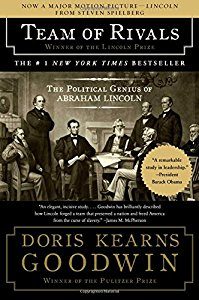On the eve of our nation’s two hundred forty-first birthday, I read Doris Kearns Goodwin’s award-winning biography Team of Rivals: The Political Genius of Abraham Lincoln. It is absolutely amazing. I highly recommend it to anyone wanting something to read when the summer gets hot and to anyone concerned about the track our state and federal governments seem to be following.
While set in the background of the Civil War, the book is by no means a shot by shot account of the horrific conflict that created disunion of states and loss of more than 750.000 lives. The tensions began with the Declaration of Independence and climaxed with the election of Abraham Lincoln, a little-known prairie lawyer from Illinois. The elections of 1860 were more chaotic than those of 2016. The Democratic Party split into two groups, both with candidates. The Republican Party was relatively new and full of a few Southern sympathizers and lots of abolitionists. None were without ill feelings. To make matters more complicated for 21st Century Americans, the Democrats of the time were the conservatives while the Republicans were much more liberal. Finally, eleven states seceded from the Union to form what they called the Confederate States of America. Incidentally, Lincoln never acknowledged the name or the country.
Lincoln waited until after his election to choose his cabinet. Amazingly, he chose four men who opposed him at the Republican Convention in the summer of 1860. Lincoln chose his chief opponent William Henry Seward for position of Secretary of State. The two became close friends. Simon Cameron reluctantly accepted position of Secretary of War, but was replaced the following year by Edwin M. Stanton. Both Seward and Stanton served until Lincoln died. Salmon P. Chase agreed to serve as Secretary of Treasury, quite a challenge during wartime. Chase and his daughter Kate continued a campaign for the Chase presidential candidacy. Chase submitted his resignation four times; Lincoln called his bluff on the last one. Edward Bates was another reluctant candidate; Lincoln cajoled him into becoming Attorney General.
Goodwin shows how Lincoln was able to hear various opinions, to soften the discord with humor and stories, while deciding the venue he would take. Often Lincoln allowed an issue to stall until he felt the nation’s citizens were ready for such a change. The Emancipation Proclamation that led to the Thirteenth Amendment was an example.
Goodwin used many primary source materials; something a great historian does. She used many of the detailed diaries kept by cabinet members. What a person writes at the time of the event is often very realistic, especially if the author believes no one will ever read it. Hence, Goodwin ably created a realistic account.
As I read Team of Rivals, I thought about challenges we face today. While I came to no definitive conclusion, I believe that Doris Kearns Goodwin’s work is an inspiration for all of us. The United States divided before and recovered. There’s hope for us today.
Have a happy and safe Fourth of July! Be thankful for the incredible rights we have.

